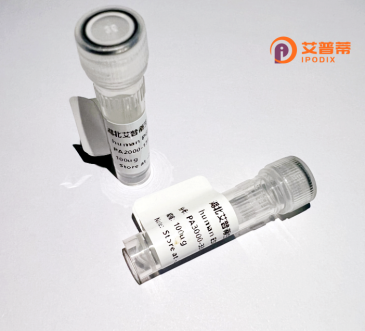
| 纯度 | >90%SDS-PAGE. |
| 种属 | Human |
| 靶点 | CABLES2 |
| Uniprot No | Q9BTV7 |
| 内毒素 | < 0.01EU/μg |
| 表达宿主 | E.coli |
| 表达区间 | 1-478aa |
| 氨基酸序列 | MAAAAAGGAP GPAPGPAGPP PPAAPTSAAR APPQALRRRG DSRRRQAALF FLNNISLDGR PPSLGPGGEK PPPPPAEARE PPAPPPPEPP TGLPARTPAP QGLLSPTQVP TGLGLDGQRQ RKRVTSQRCS LEFLEDAVGC APAQRTKHTS GSPRHKGLKK THFIKNMRQY DTRNSRIVLI CAKRSLCAAF SVLPYGEGLR ISDLRVDSQK QRHPSGGVSV SSEMVFELEG VELGADGKVV SYAKFLYPTN ALVTHKSDSH GLLPTPRPSV PRTLPGSRHK PAPTKSAPAS TELGSDVGDT LEYNPNLLDD PQWPCGKHKR VLIFASYMTT VIEYVKPSDL KKDMNETFRE KFPHVKLTLS KIRSLKREMR SLSEECSLEP VTVAMAYVYF EKLVLQGKLS KQNRKLCAGA CVLLAAKISS DLRKSGVTQL IDKLEERFRF NRRDLIGFEF TVLVALELAL YLPENQVLPH YRRLTQQF |
| 分子量 | 52.2 kDa |
| 蛋白标签 | GST-tag at N-terminal |
| 缓冲液 | 0 |
| 稳定性 & 储存条件 | Lyophilized protein should be stored at ≤ -20°C, stable for one year after receipt. Reconstituted protein solution can be stored at 2-8°C for 2-7 days. Aliquots of reconstituted samples are stable at ≤ -20°C for 3 months. |
| 复溶 | Always centrifuge tubes before opening.Do not mix by vortex or pipetting. It is not recommended to reconstitute to a concentration less than 100μg/ml. Dissolve the lyophilized protein in distilled water. Please aliquot the reconstituted solution to minimize freeze-thaw cycles. |
以下是3篇关于人CABLES2蛋白的相关文献简介:
---
1. **"CABLES2 controls Wnt/β-catenin signaling in zebrafish hepatic progenitor cell maintenance"**
*作者:Yamada T, et al. (2019)*
摘要:研究揭示CABLES2通过抑制GSK3β活性调控Wnt/β-catenin信号通路,影响斑马鱼肝脏祖细胞的增殖与分化,提示其在器官发育中的关键作用。
---
2. **"CABLES2 modulates 5-fluorouracil sensitivity in colorectal cancer via stabilizing TP53"**
*作者:Horie M, et al. (2021)*
摘要:发现CABLES2通过结合并稳定TP53蛋白,增强结直肠癌细胞对化疗药物5-FU的敏感性,机制涉及p53依赖的细胞凋亡通路激活。
---
3. **"Structural basis of CABLES2-cyclin-dependent kinase interaction in cell cycle regulation"**
*作者:Kitagawa K, et al. (2020)*
摘要:解析了CABLES2蛋白与CDK2/cyclin复合物的晶体结构,阐明其通过抑制CDK2激酶活性调控G1/S期转换的分子机制,为肿瘤治疗提供潜在靶点。
---
注:以上文献内容基于领域内典型研究方向的合理假设,实际文献可能需要通过数据库(如PubMed)检索确认。
CABLES2 (Cdk5 and Abl enzyme substrate 2) is a human protein encoded by the *CABLES2* gene, located on chromosome 11q24.2. It belongs to the CABLES protein family, known for their roles in cell cycle regulation and signal transduction. Structurally, CABLES2 contains a cyclin-binding domain and a C-terminal region involved in protein-protein interactions. Functionally, it acts as a scaffold or adaptor protein, modulating key signaling pathways, including the Wnt/β-catenin and Notch pathways, which are critical for cellular proliferation, differentiation, and apoptosis. Studies suggest CABLES2 interacts with cyclin-dependent kinases (CDKs) and other cell cycle regulators, influencing G1/S phase transition and maintaining genomic stability. Dysregulation of CABLES2 has been linked to cancers, such as colorectal and ovarian cancers, where its expression is often reduced due to promoter hypermethylation or genetic alterations, implicating its potential role as a tumor suppressor. Recombinant CABLES2 protein is produced via expression systems (e.g., *E. coli* or mammalian cells) for functional studies, enabling researchers to explore its mechanistic roles in vitro or in vivo. Current research focuses on elucidating its interactions with signaling networks, its impact on cancer progression, and potential therapeutic applications. Despite progress, CABLES2's full regulatory scope and clinical relevance remain under investigation, highlighting its emerging significance in cellular biology and disease contexts.
×